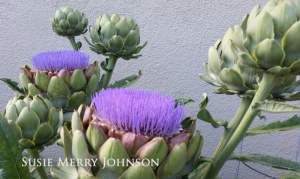 Whether it’s the edible unopened buds or the purple choke flowers, there’s a lot to love about growing artichokes at home. The plants also give an interesting vertical structure to your vegetable garden. In this post, Seasonal Wisdom celebrates artichokes! Learn more about planting this pretty perennial in your garden this season.
Whether it’s the edible unopened buds or the purple choke flowers, there’s a lot to love about growing artichokes at home. The plants also give an interesting vertical structure to your vegetable garden. In this post, Seasonal Wisdom celebrates artichokes! Learn more about planting this pretty perennial in your garden this season.
Native to the Mediterranean, artichokes were among the earliest cultivated vegetables.
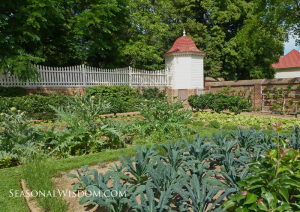 In the early days of the United States, artichokes were a popular food among the gentleman farmers. According to Mount Vernon, artichokes were one of George Washington’s favorite vegetables. Here, artichokes can be seen growing at the former president’s kitchen garden at Mount Vernon a few summers ago, along with kale and lettuces. Thomas Jefferson also grew artichokes at Monticello, a few hours south.
In the early days of the United States, artichokes were a popular food among the gentleman farmers. According to Mount Vernon, artichokes were one of George Washington’s favorite vegetables. Here, artichokes can be seen growing at the former president’s kitchen garden at Mount Vernon a few summers ago, along with kale and lettuces. Thomas Jefferson also grew artichokes at Monticello, a few hours south.
Perennial or Annual?
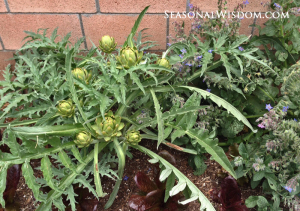 Coastal California is a rather idyllic place to grow artichokes, where they grow as perennials. Artichokes thrive in this region’s mild winters and cool, foggy summers. In my Southern California garden, my one-year-old artichoke plant (shown above) is very happy growing next to borage flowers with red romaine lettuces underneath.
Coastal California is a rather idyllic place to grow artichokes, where they grow as perennials. Artichokes thrive in this region’s mild winters and cool, foggy summers. In my Southern California garden, my one-year-old artichoke plant (shown above) is very happy growing next to borage flowers with red romaine lettuces underneath.
Experts warn that artichoke plants typically won’t produce much the first year, but my plant has grown more than 10 chokes in its inaugural growing season. So, it must be happy here.
In USDA Zones 7 to 9, you may be able to overwinter artichokes by pruning and mulching them well after blooming. In colder climates, you’ll probably need to grow artichokes as an annual.
Growing Conditions
Artichokes like full sun to partial shade. They grow best in moist, fertile and well-drained soil. Over time, artichokes can grow 3 to 4 feet tall, and up to 4 feet wide in ideal growing conditions. So, make sure you like the location where you planted them. During their active growing season, feed artichokes with a well-balanced fertilizer once a month.
Try to avoid letting the plants suffer from either summer drought, or wet, soggy soil in winter. Adding compost to the soil will improve its texture, encourage good drainage yet also help retain water in the soil.
 Harvest artichokes when they are still tightly closed. Otherwise, the artichoke will eventually bloom into a pretty purple thistle flower, which can be enjoyed in flower arrangements fresh or dried. I’m still waiting for mine to bloom, but isn’t this one from my neighbor’s garden gorgeous?
Harvest artichokes when they are still tightly closed. Otherwise, the artichoke will eventually bloom into a pretty purple thistle flower, which can be enjoyed in flower arrangements fresh or dried. I’m still waiting for mine to bloom, but isn’t this one from my neighbor’s garden gorgeous?
After artichokes stop producing, prune the plants back by a third to hopefully generate another growth flush in the early-fall.
Eating Artichokes
“Life is like eating artichokes; you have got to go through so much to get so little.”
Thomas Aloysius (Tad) Dorgan, Cartoonist
It’s true that artichokes require some preparation, whether you steam, boil or microwave them. But the vegetable definitely has its fans who cherish each and every bite.
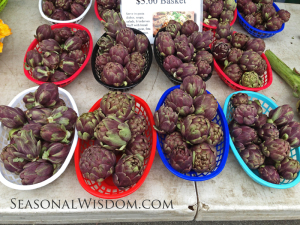 As this farmers market sign reminds, you can use artichokes in pasta dishes, soups, salads and appetizers. Try stuffing them with bread, ground meat, feta cheese and nuts. I like to dip the cooked artichoke leaves in melted butter with lemon juice and a sprinkle of white wine with marjoram, tarragon and thyme leaves. Others swear by mayonnaise and other dips.
As this farmers market sign reminds, you can use artichokes in pasta dishes, soups, salads and appetizers. Try stuffing them with bread, ground meat, feta cheese and nuts. I like to dip the cooked artichoke leaves in melted butter with lemon juice and a sprinkle of white wine with marjoram, tarragon and thyme leaves. Others swear by mayonnaise and other dips.
The California Artichoke Advisory Board offers step-by-step instructions and recipes for eating artichokes.
“In the centre of a spacious table rose a pastry as large as a church, flanked on the north by a quarter of cold veal, on the south by an enormous ham, on the east by a monumental pile of butter, and on the west by an enormous dish of artichokes, with a hot sauce.”
Jean-Anthelme Brillat-Savarin, (1755-1826) ‘The Physiology of Taste’
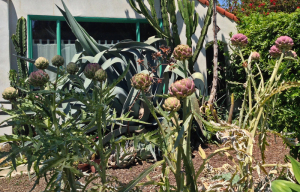











Comments on this entry are closed.